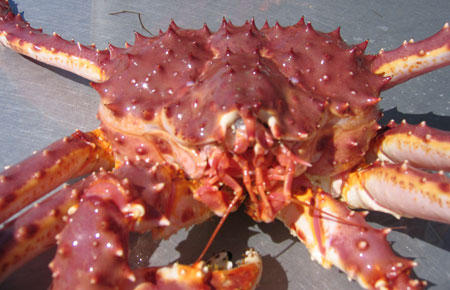It’s going to be a down year for crabbing in the Bering Sea and Aleutian Islands fisheries. Several fisheries will be closed, and others will have reduced harvest quotas. The unwelcome news from Alaska’s Department of Fish & Game last week was not unexpected after a summer survey reported in late August that crab stocks were down.

The National Marine Fisheries Service annual summer survey across the Bering Sea and Aleutian Islands came back with the not good news that crab stocks were down. State fisheries biologist Miranda Westphal in Unalaska said this year’s findings are keeping with a recent trend.
“Overall we’ve been seeing the last couple seasons of them surveying that crab stocks in general have been in decline,” Westphal said. “So this season certainly wasn’t a surprise for anyone either.” (BSAI are federal fisheries managed by the state.)
The news releases from Fish and Game on the coming crab fisheries trickled out all last week. First, the quota for the Bristol Bay red king crab, which opens this Saturday, will be cut 15 percent. Announcements then came down for the closure of Pribilof red and blue king crab, then the closure of tanner crab, and then the closure of Saint Matthew Island blue king crab. The last announcement of a near 50 percent reduction of the Bering Sea snow crab harvest came Thursday.
Westphal calls this a down year for BSAI fisheries, but said crabs are cyclical and things will hopefully improve in a year or two.
“I feel like, just looking at past fishery data, past stock data, that we’re just in one of the low cycles right now,” Westphal said. “The NMFS trawl survey happens every summer, so we’ll just have to wait and see what it looks like next summer. But the hope is that it will turn around fairly quickly.”
The BSAI crab industry is worth hundreds of millions of dollars every year. In 2014 for example, 108 vessels fished, employing 1200 crew and landing some 81 million pounds of crab with an ex-vessel value of $246 million. The wholesale value of the processed 53.2 million pounds was estimated at $331 million, according to NOAA.
The Bristol Bay Economic Development Corporation partners with nine vessels that fish crab. CEO Norm Van Vactor said this year’s quota reductions and crab closures will be costly for the CDQ, probably in the millions of dollars of lost revenue.
“There’s less crab for the boats to catch,” Van Vactor said. “There’s less crab for our salespeople to sell. There’s less opportunity on a margin basis per pound for BBEDC to generate revenue. And of course it’s these types of revenue that feed and support our programs,” he said.
Right now, with Bering Sea snow crab and Bristol Bay red king crab opening Saturday, crabbers are making tough choices on how to fish this season. For BBEDC, that means “optimizing the efficiency of the fleet,” according to Van Vactor.
“Do we tie a boat up, do we move quota from one boat to the other boats that are fishing, do we just kind of share the pain equally between the vessel? Because remember, we’re in this with partners, with other people and with the crew, and so everybody kind of shares in the good times and everybody shares in the bad times,” Van Vactor said.
He said if there is a silver lining, smaller landings could translate to higher prices, though that’s far from guaranteed.
Decisions about crab harvest quotas are made after the NMFS summer trawl survey data is in. Van Vactor said industry is calling on NMFS and the state managers to reconsider this sole, standard method to count the crabs on the ocean floor.
“There is a strong feeling, and we’re certainly seeing it in our other fisheries and in particular around our cod boats, they’re seeing more crab than they’ve seen in a long time,” Van Vactor said. “So the feeling is we’re dealing with changing water temperatures. We’ve had a warm ‘blob’ in the Gulf of Alaska, there have been different temperature currents in the Bering Sea. The feeling is that the crab resource is probably actually quite healthy, but they’re just not in their traditional areas.”
Conversations about the survey and management of BSAI crab fisheries will continue this fall and winter. Nothing is likely to change what is now set to be a down year of reduced opportunity for crabbing in the Bering Sea and Aleutian Islands.




